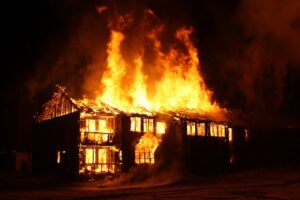
With fire incidents across the country rising with alarming regularity, the fire protection industry is also gearing to bring in innovations but they need to be backed up with missionary zeal and concerted cooperation of the citizens. A look at what’s current in today’s scenario
Fire safety makes for a complex algorithm. With all its safety protocols, compliances, SOPs, the resilience, perseverance and heroics of the fire-fighters and the cooperation of conscientious citizens, a fire incident throws up new challenges each time, depending upon its magnitude, gravity and the place of its occurrence.
Fires pose a major hazard to various occupancies in India. Hardly a day is lost when a fire is not reported across the country. The fires not only claim precious lives, they also inflict heavy loss of property, leaving behind sometimes trauma that lingers for a long time. This makes fire-fighting a perennial challenge where each incident has a new lesson to offer and calls for constant innovations that new challenges throw up.
Fire protection systems play a crucial role in safeguarding lives and property from the devastating effects of fire. With unbridled urbanization and industrialization, the demand for efficient and advanced fire protection systems has increased manifold.
Mumbai can be considered as an ideal case study for such challenges. In the last two decades, there has been a vibrant growth in the construction activity in the metropolis especially high-rise buildings. Because of its peculiar nature, fire in residential buildings, in particular, high-rise buildings, become more complex and the salvaging operations more difficult and sometimes even resulting in many deaths and huge property losses. Also, the rapid modernisation of Indian industry has queered the pitch for the authorities constantly grappling with this scenario. Awareness towards fire safety has not been quite forthcoming, looking to the increasing number of fire incidents.
The alarming frequency of fire outbreaks in India has catapulted fire safety to the forefront of public concern. The nation grapples with a myriad of challenges, including tough and tricky enforcement of fire safety regulations, inadequate infrastructure, and illegal constructions flouting safety norms. Regardless of occupancy – be it homes, workplaces, hospitals, or public spaces like theatres and malls – the potential for fire-related accidents persists.
Statistics reveals that, on average, 25,000 people lose their lives annually due to fires and related causes in India, with females constituting about 66% of the victims. The economic losses from these incidents are substantial and call for robust fire protection measures. Loss of lives and property can be avoided if due diligence is exercised in fire protection.
An interesting piece of statistic also emerges on the economic toll front as over 45% of claims reported by Indian insurance companies were due to fire losses. India witnessed a staggering 11,037 reported fire accidents in 2020, underlining the gravity of the situation. Tragic incidents like the Kamala Mills fire in Mumbai (2017), Surat coaching centre blaze (2019), and the Delhi factory fire (2020) epitomise the human cost of fire-related hazards. There is a lack of comprehensive data on economic losses related to fires.
In the light of this situation, it would be worthwhile to delve into the current scenario of fire protection manufacturing in India, highlighting the innovations, challenges, and potential future trends in the industry. Some of these innovations are:
*Advanced Detection Technology: Modern fire protection systems are increasingly incorporating advanced detection technologies such as smoke, heat, and flame detectors. These technologies enhance the system’s ability to detect fires at an early stage, enabling faster response times and reducing potential damage.
*Integrated and IoT-enabled Systems: The integration of fire protection systems with Internet of Things (IoT) technology allows for real-time monitoring and remote management of these systems. It improves the overall efficiency and effectiveness of fire protection, enabling prompt response and maintenance.
*Waterless Fire Suppression: In areas where traditional water-based firefighting methods are not suitable, waterless fire suppression systems, such as gas-based or aerosol-based systems, are gaining traction. These systems can effectively control fires without causing water damage to sensitive equipment and materials.
*Eco-Friendly Solutions: The industry is witnessing a shift towards environmental-friendly fire protection solutions. Manufacturers are developing systems that use less harmful chemicals and materials, minimizing the impact on the environment while ensuring effective fire suppression.
However, innovations are just one side of the coin. They also come with challenges. Some notable ones are:
*Regulatory Compliance: Fire protection industry is subject to various regulations and standards that manufacturers must adhere to. Keeping up with evolving regulations and ensuring compliance can be challenging, especially as standards may vary across different states and regions.
*Skilled Workforce Shortage: Manufacturing and maintaining advanced fire protection systems require a skilled workforce with expertise in areas such as engineering, electronics, and software. A shortage of such skilled professionals can impact the industry’s growth and innovation potential.
*Price Sensitivity: Cost is a significant factor in the adoption of fire protection systems, particularly in price-sensitive markets. Balancing affordability with advanced technology can be a challenge for manufacturers, as cheaper alternatives might compromise system effectiveness.
*Awareness and Education: Raising awareness about the importance of fire protection systems and their benefits remains an unending challenge. Educating businesses, homeowners, and local authorities about the need for proper fire safety measures is essential to drive the demand for advanced fire protection solutions.
In the midst of emerging innovations and relentless challenges, future trends also need mention. These include:
*Data-Driven Insights: The integration of data analytics and artificial intelligence will enable fire protection systems to gather and analyze data for predictive maintenance, improving system reliability and performance.
*Modular and Scalable Systems: Manufacturers are likely to develop modular systems that can be easily expanded or adapted to changing environments, reducing the need for complete system overhauls.
*Increased Automation: Automation in fire protection systems will lead to quicker response times and more efficient firefighting strategies, minimizing human intervention in high-risk situations.
*Renewable Energy Integration: The use of renewable energy sources, such as solar power, for fire protection system components will contribute to sustainable and resilient solutions.
It is heartening that the fire protection system manufacturing industry in India is experiencing a shift towards advanced technologies, sustainability, and integrated solutions. While challenges persist, innovative approaches and a focus on compliance, skilled workforce development, and public awareness will drive the industry forward.

A Column By
Raju Korti – Editor
The Resource 24X7
A Journalist With 4 Decades of Experience With Leading Media Houses.
